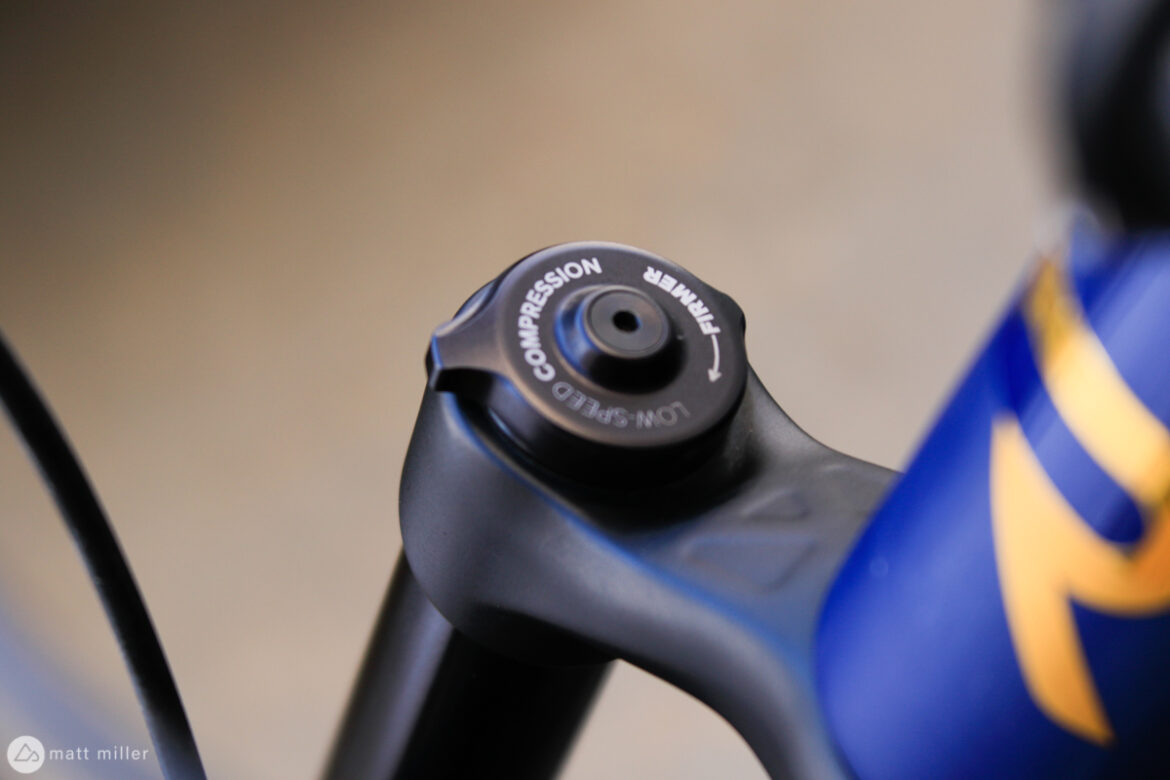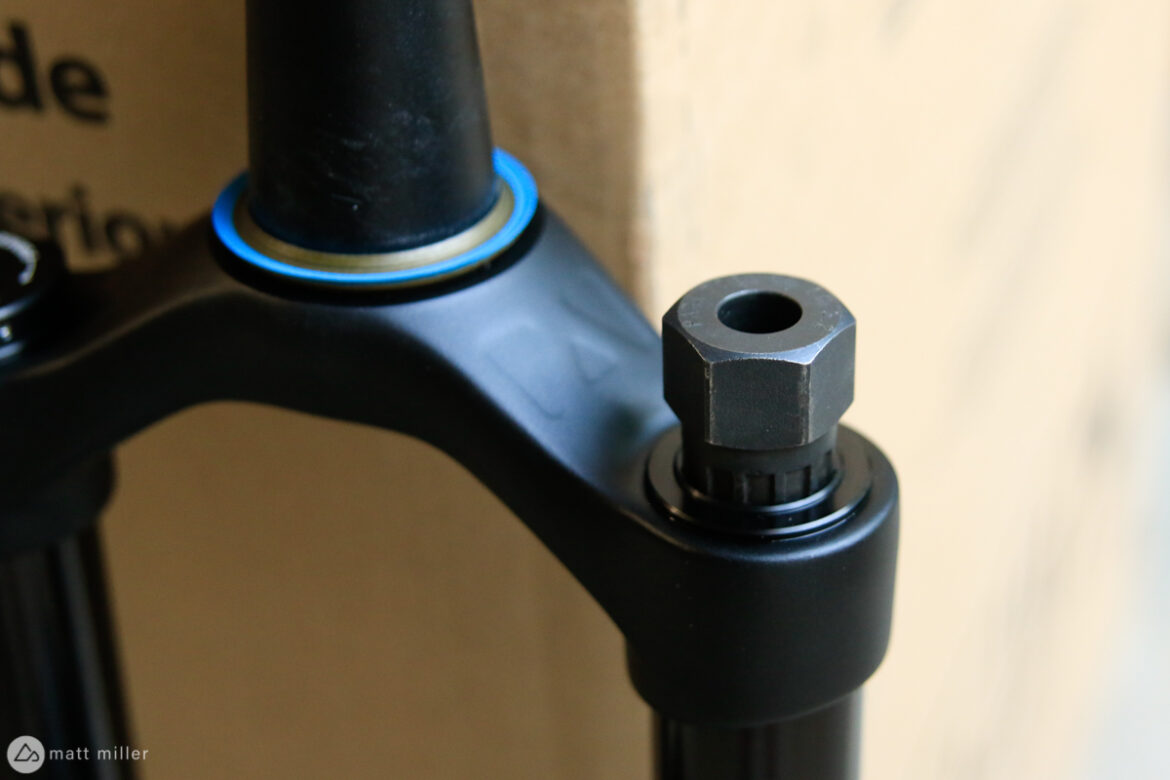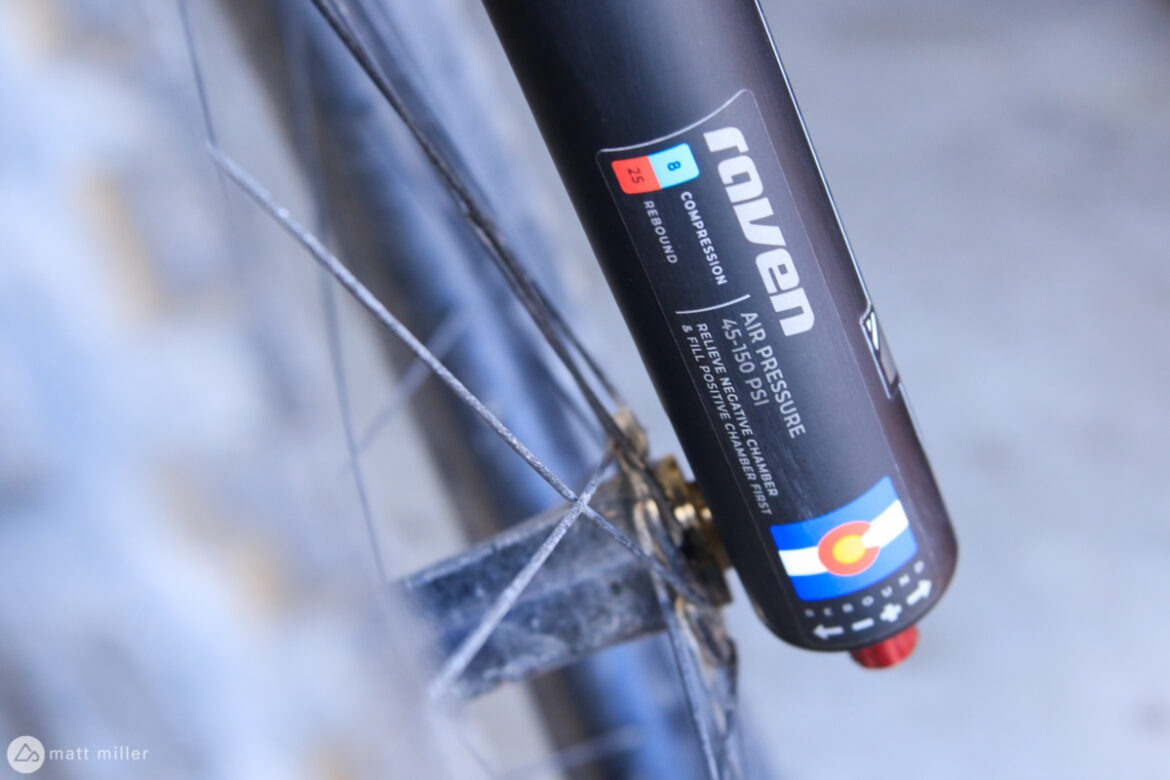
Mountain Racing Products (MRP) is probably more widely known for their chain guides and frame-saving bash guards, but their fork and suspension options can be even more intriguing. MRP has forks in a few different categories now which should cover just about everyone. They have a rigid fork, a 40mm-travel gravel fork, a few lighter XC and trail forks, all-mountain/enduro forks, and a gravity fork.
The Raven is their newest option and takes the frame and 35mm stanchions of the Ribbon enduro fork, and cuts some of the features for a stiff and sturdy, high-performance fork at a lower price. By eliminating the Ramp Control variable progression system, and the PSST pressure relief valves in the lowers, the Raven sells for almost $200 less than the Ribbon. But, it keeps the twin-tube damper and FulFill air spring which give the forks the majority of their performance. The fork still has eight positions for low-speed compression and 25 low-speed rebound clicks.
Also on the Raven, is the signature MRP Outcast arch, to prevent mud from building up. The fork comes in both 27.5″ and 29″ sizes, in either regular or reduced offsets with travel ranging from 120-160mm, and the travel is internally adjustable. Tire clearance allows for a 2.6-inch-wide 29er or a 3.0-inch-wide 27.5 tire, but the fork is only available in Boost spacing. However, MRP does have great Boost adapter options for certain hubs. The Raven is made to work with 180mm rotors on its post mounts. My sample of the Raven is a 51mm offset, 140mm travel 29er fork and after the steerer tube was cut with the Ready to Shred program, it weighs in at 1,931g or 4.2lbs. MRP includes additional volume spacers and travel spacers to make travel adjustments.
On the trail

I opted to go through MRP’s new Ready to Shred program where they cut the steerer tube and install the star nut, and I highly recommend it. It saves the installer time, and the factory cuts are probably much nicer. It also saves the user a bunch of time trying to figure out the best settings for the damn fork – something that can be frustrating to do alone. Enter your riding weight, typical riding terrain, steerer tube length, rotor size, and whether you want the fork dialed for comfort or performance. To make it even more personalized, the rider can pick one of 12 decal choices and a customized serial number.
Based solely on MRP’s recommendations from Ready to Shred, the Raven felt great, right after a quick installation. From there, I only wanted to try minute adjustments. Stated simply, tuning the Raven involves adjusting low-speed compression and rebound, a positive and negative air chamber, and the desired amount of “Huck Pucks.” My Raven came set to 77 PSI in the positive chamber, 84 PSI in the negative, one volume spacer, and 13 clicks of rebound damping (from closed) out of 25. These settings were based on my choices on Ready to Shred and were optimized for comfort and riding on varied terrain. Out of the box, the Raven felt sensitive to my traction needs, supportive through corners and mid-support, but a little too eager to use all of its travel on larger drops.
The idea of having two independent air chambers comes down to greater adjustability and getting a distinct feel from the fork’s initial stroke for small bump sensitivity. Since the smaller negative chamber works against the positive air chamber, adding air to the negative makes the fork more supple.
Adjusting the two chambers requires the rider to discharge all the air from the negative, set the desired pressure in the positive, and recharge the negative at the bottom of the port-side stanchion. It’s also important for the negative chamber to be within 10PSI of the positive. I found that if it wasn’t, or if I had the negative higher than 10SPI above the positive, the fork lost some of its travel and would rest into its stroke. The FulFill air spring requires the user to be more mindful than setting up a traditional self-equalizing positive and negative air chambered fork, but again, it’s nice to have that option for tuning on a more affordable fork.

I added another volume spacer for a greater ramp up, and continued to play with pressures in the positive and negative air chambers, but then returned to a small range based off MRP’s initial pressure settings, because they felt the most balanced and suited to my needs. I have also been adding or removing a click of rebound depending on the terrain, and of course, have done the same with the low-speed compression (LSC) dial.
I usually set the LSC to between 3-5 clicks out of eight in for more support as the Raven can feel like it rides a little deep in its travel. There is a tradeoff with small bump compliance, but it’s far from feeling harsh.
With two volume spacers in, the fork is saving more travel near the end. On a Fox 36 fork, I usually ride with one spacer, which would save me more travel at the end of bigger drops. That remaining travel can be reassuring, but sometimes reserves too much space. With the MRP, it felt more adept at using nearly all of the 140mm of travel more often.
Having switched to the Raven from the Ohlins RFX36 m.2, I couldn’t detect any noticeable amount of flex. The MRP fork felt stiff and responsive under steering and through technical trails, and confident soaking up bigger hits.
The Raven also has some nice features around the chassis. Rather than marring up the top cap, something that can still happen over time, even with the correct socket, the top cap uses a cassette lock ring tool to open up the air chamber. A nice little air cap tops it off and keeps it looking new. I haven’t heard a peep or squeak from the chassis, though the damper isn’t the quietest.
Who’s it for?

MRP provides a high performance fork with the Raven at a lower price point than the Ribbon, without a few features that some might not want or need. The absence of the PSST valves doesn’t bother me, as built up pressure in the lowers isn’t a huge or frequent problem, and can be easily resolved by the ol’ zip tie trick. I don’t mind manually inserting volume spacers either, since that is the case with most forks and I don’t usually need a lot of adjustability here. For myself, saving $200 on the Raven is an easy choice over the Ribbon.
At $800, MRP puts the Raven in competition with other sub-$1000 forks like the Marzocchi Bomber Z1 ($700) or the Cane Creek Helm ($900). Both are heavier. The Bomber Z1 feels stiffer, but lacks the adjustability of the Raven and doesn’t feel as sensitive off the top. The Helm offers quite a bit more adjustability, including independent positive and negative air chambers, and high and low speed compression adjustments.
The amount of adjustability on the Raven seems to fit in the market as being more than the standard LSC and rebound found anywhere, but not overly complex for a fair price.
Closing thoughts

MRP makes a unique fork offering with the $800 Raven (available at Competitive Cyclist and other online retailers). The fork holds an above average amount of adjustability, but not so much that the rider gets lost. The independent air chambers can call for some experimenting, but again, they are easy to demystify. With options like Ready to Shred, the Outcast arch, and decal choices, consumers get a distinct piece of suspension to head up their bike.























0 Comments